Adaption of FMDV Asia-1 to Suspension Culture: Cell Resistance Is Overcome by Virus Capsid Alterations
Abstract
:1. Introduction
2. Materials and Methods
2.1. Cells
2.2. Susceptibility of BHK-2P for FMDV Stock Viruses
2.3. Virus Titrations
2.4. Storage Conditions
2.5. pH Sensitivity
2.6. Blockage of Endosomal Acidification with Ammonium Chloride
2.7. RNA Transfection and Immunofluorescence
2.7.1. RNA Transfection
2.7.2. Immunofluorescent Staining
2.8. Susceptibility of Other Cell Lines and Cross-Infection Experiments
2.8.1. Susceptibility of Other Cell Lines
2.8.2. Infection and Virus Adaption Experiments
2.8.3. Attachment Test
2.8.4. Sequence and Structure Analysis
2.9. Infectivity Assay on Receptor-Deficient Cells
2.10. Virus Neutralization Test
2.11. Statistical Analysis
3. Results
3.1. FMDV Serotype Asia-1 Cannot Infect BHK-2P Cells
3.2. The Ability of FMDV to Infect BHK-2P is not Dependent on the Culture Environment
3.3. BHK-2P Cells Can Produce Infectious Asia-1 FMDV
3.4. Cellular Resistance Can be Overcome by Virus Adaption to a “Wet Nurse” Cell Line
3.5. Sequence Analysis Revealed Mutations in the Five-Fold Axis and Extended Receptor Tropism
3.6. Virus Adaptation Alters Neutralization Profile
4. Discussion
Supplementary Materials
Acknowledgments
Author Contributions
Conflicts of Interest
References
- Brito, B.P.; Rodriguez, L.L.; Hammond, J.M.; Pinto, J.; Perez, A.M. Review of the global distribution of foot-and-mouth disease virus from 2007 to 2014. Transbound. Emerg. Dis. 2017, 64, 316–332. [Google Scholar] [CrossRef] [PubMed]
- Doel, T.R. FMD vaccines. Virus Res. 2003, 91, 81–99. [Google Scholar] [CrossRef]
- MacPherson, I.; Stoker, M. Polyoma transformation of hamster cell clones—An investigation of genetic factors affecting cell competence. Virology 1962, 16, 147–151. [Google Scholar] [CrossRef]
- Capstick, P.B.; Telling, R.C.; Chapman, W.G.; Stewart, D.L. Growth of a cloned strain of hamster kidney cells in suspended cultures and their susceptibility to the virus of foot-and-mouth disease. Nature 1962, 195, 1163–1164. [Google Scholar] [CrossRef] [PubMed]
- Telling, R.C.; Elsworth, R. Submerged culture of hamster kidney cells in a stainless steel vessel. Biotechnol. Bioeng. 1965, 7, 417–434. [Google Scholar] [CrossRef]
- Amadori, M.; Berneri, C.; Archetti, I.L. Immunogenicity of foot-and-mouth disease virus grown in BHK-21 suspension cells. Correlation with cell ploidy alterations and abnormal expression of the α5β1 integrin. Vaccine 1994, 12, 159–166. [Google Scholar] [CrossRef]
- Amadori, M.; Volpe, G.; Defilippi, P.; Berneri, C. Phenotypic features of BHK-21 cells used for production of foot-and-mouth disease vaccine. Biologicals 1997, 25, 65–73. [Google Scholar] [CrossRef] [PubMed]
- Brown, F. Problems with BHK 21 cells. Dev. Biol. Stand. 1998, 93, 85–88. [Google Scholar] [PubMed]
- Clarke, J.B.; Spier, R.E. Variation in the susceptibility of BHK populations and cloned cell lines to three strains of foot-and-mouth disease virus. Arch. Virol. 1980, 63, 1–9. [Google Scholar] [CrossRef] [PubMed]
- Clarke, J.B.; Spier, R.E. An investigation into causes of resistance of a cloned line of BHK cells to a strain of foot-and-mouth disease virus. Vet. Microbiol. 1983, 8, 259–270. [Google Scholar] [CrossRef]
- Syusyukin, A.A.; Tsvetkova, N.E.; Kudryatseva, G.A.; Syusyukin, M.S.; Efimov, N.I. Cultures of foot-and-mouth disease virus in different sublines of BHK 21 cells. Veterinariya (Moscow) 1976, 51, 46–48. [Google Scholar]
- Diderholm, H.; Dinter, Z. A Line of polyoma-transformed BHK21 Cells insusceptible to foot-and-mouth disease virus. Virology 1965, 26, 369–372. [Google Scholar] [CrossRef]
- Spearman, C. The method of “right and wrong cases” (constant stimuli) without Gauss’s formula. Br. J. Psychol. 1908, 2, 227–242. [Google Scholar]
- Kärber, G. Beitrag zur kollektiven Behandlung pharmakologischer Reihenversuche. Arch. Exp. Pathol. Pharmakol. 1931, 162, 480–483. [Google Scholar] [CrossRef]
- Martin-Acebes, M.A.; Rincon, V.; Armas-Portela, R.; Mateu, M.G.; Sobrino, F. A single amino acid substitution in the capsid of foot-and-mouth disease virus can increase acid lability and confer resistance to acid-dependent uncoating inhibition. J. Virol. 2010, 84, 2902–2912. [Google Scholar] [CrossRef] [PubMed]
- Callahan, J.D.; Brown, F.; Osorio, F.A.; Sur, J.H.; Kramer, E.; Long, G.W.; Lubroth, J.; Ellis, S.J.; Shoulars, K.S.; Gaffney, K.L.; et al. Use of a portable real-time reverse transcriptase-polymerase chain reaction assay for rapid detection of foot-and-mouth disease virus. J. Am. Vet. Med. Assoc. 2002, 220, 1636–1642. [Google Scholar] [CrossRef] [PubMed]
- Schneider, C.A.; Rasband, W.S.; Eliceiri, K.W. NIH Image to ImageJ: 25 years of image analysis. Nat. Methods 2012, 9, 671–675. [Google Scholar] [CrossRef] [PubMed]
- Brown, F.; Cartwright, B.; Stewart, D.L. Further studies on the infection of pig-kidney cells by foot-and-mouth disease virus. Biochim. Biophys. Acta 1962, 55, 768–774. [Google Scholar] [CrossRef]
- Dill, V.; Beer, M.; Hoffmann, B. Simple, quick and cost-efficient: A universal RT-PCR and sequencing strategy for genomic characterisation of foot-and-mouth disease viruses. J. Virol. Methods 2017, 246, 58–64. [Google Scholar] [CrossRef] [PubMed]
- Carrillo-Tripp, M.; Montiel-Garcia, D.J.; Brooks, C.L., 3rd; Reddy, V.S. CapsidMaps: Protein-protein interaction pattern discovery platform for the structural analysis of virus capsids using Google Maps. J. Struct. Biol. 2015, 190, 47–55. [Google Scholar] [CrossRef] [PubMed]
- Fry, E.; Acharya, R.; Stuart, D. Methods used in the structure determination of foot-and-mouth disease virus. Acta Crystallogr. Sect. A Found. Crystallogr. 1993, 49, 45–55. [Google Scholar] [CrossRef]
- Fry, E.E.; Newman, J.W.; Curry, S.; Najjam, S.; Jackson, T.; Blakemore, W.; Lea, S.M.; Miller, L.; Burman, A.; King, A.M.; et al. Structure of foot-and-mouth disease virus serotype A1061 alone and complexed with oligosaccharide receptor: Receptor conservation in the face of antigenic variation. J. Gen. Virol. 2005, 86, 1909–1920. [Google Scholar] [CrossRef] [PubMed]
- Pettersen, E.F.; Goddard, T.D.; Huang, C.C.; Couch, G.S.; Greenblatt, D.M.; Meng, E.C.; Ferrin, T.E. UCSF Chimera—A visualization system for exploratory research and analysis. J. Comput. Chem. 2004, 25, 1605–1612. [Google Scholar] [CrossRef] [PubMed]
- Jackson, T.; Sheppard, D.; Denyer, M.; Blakemore, W.; King, A.M. The epithelial integrin αvβ6 is a receptor for foot-and-mouth disease virus. J. Virol. 2000, 74, 4949–4956. [Google Scholar] [CrossRef] [PubMed]
- World Organisation for Animal Health (OIE). Foot and Mouth Disease. Manual of Diagnostic Tests and Vaccines for Terrestrial Animals. Available online: http://www.oie.int/fileadmin/Home/eng/Health_standards/tahm/2.01.08_FMD.pdf (accessed on 8 February 2017).
- Bates, D.; Mächler, M.; Bolker, B.; Walker, S. Fitting linear mixed-effects models using lme4. J. Stat. Softw. 2015, 67, 1–48. [Google Scholar] [CrossRef]
- Grubman, M.J.; Baxt, B. Foot-and-mouth disease. Clin. Microbiol. Rev. 2004, 17, 465–493. [Google Scholar] [CrossRef] [PubMed]
- Genzel, Y. Designing cell lines for viral vaccine production: Where do we stand? Biotechnol. J. 2015, 10, 728–740. [Google Scholar] [CrossRef] [PubMed]
- Jackson, T.; Mould, A.P.; Sheppard, D.; King, A.M. Integrin alphavbeta1 is a receptor for foot-and-mouth disease virus. J. Virol. 2002, 76, 935–941. [Google Scholar] [CrossRef] [PubMed]
- Jackson, T.; Clark, S.; Berryman, S.; Burman, A.; Cambier, S.; Mu, D.; Nishimura, S.; King, A.M. Integrin αvβ8 functions as a receptor for foot-and-mouth disease virus: Role of the β-chain cytodomain in integrin-mediated infection. J. Virol. 2004, 78, 4533–4540. [Google Scholar] [CrossRef] [PubMed]
- Berinstein, A.; Roivainen, M.; Hovi, T.; Mason, P.W.; Baxt, B. Antibodies to the vitronectin receptor (integrin α V β 3) inhibit binding and infection of foot-and-mouth disease virus to cultured cells. J. Virol. 1995, 69, 2664–2666. [Google Scholar] [PubMed]
- Duque, H.; Baxt, B. Foot-and-mouth disease virus receptors: Comparison of bovine αV integrin utilization by type A and O viruses. J. Virol. 2003, 77, 2500–2511. [Google Scholar] [CrossRef] [PubMed]
- Jackson, T.; Ellard, F.M.; Ghazaleh, R.A.; Brookes, S.M.; Blakemore, W.E.; Corteyn, A.H.; Stuart, D.I.; Newman, J.W.; King, A.M. Efficient infection of cells in culture by type O foot-and-mouth disease virus requires binding to cell surface heparan sulfate. J. Virol. 1996, 70, 5282–5287. [Google Scholar] [PubMed]
- O’Donnell, V.; Larocco, M.; Baxt, B. Heparan sulfate-binding foot-and-mouth disease virus enters cells via caveola-mediated endocytosis. J. Virol. 2008, 82, 9075–9085. [Google Scholar] [CrossRef] [PubMed]
- O’Donnell, V.; LaRocco, M.; Duque, H.; Baxt, B. Analysis of foot-and-mouth disease virus internalization events in cultured cells. J. Virol. 2005, 79, 8506–8518. [Google Scholar] [CrossRef] [PubMed]
- Walther, C.G.; Whitfield, R.; James, D.C. Importance of interaction between integrin and actin cytoskeleton in suspension adaptation of CHO cells. Appl. Biochem. Biotechnol. 2016, 178, 1286–1302. [Google Scholar] [CrossRef] [PubMed]
- Mohapatra, J.K.; Pandey, L.K.; Rai, D.K.; Das, B.; Rodriguez, L.L.; Rout, M.; Subramaniam, S.; Sanyal, A.; Rieder, E.; Pattnaik, B. Cell culture adaptation mutations in foot-and-mouth disease virus serotype A capsid proteins: Implications for receptor interactions. J.Gen. Virol. 2015, 96 Pt 3, 553–564. [Google Scholar] [CrossRef] [PubMed]
- Berryman, S.; Clark, S.; Kakker, N.K.; Silk, R.; Seago, J.; Wadsworth, J.; Chamberlain, K.; Knowles, N.J.; Jackson, T. Positively charged residues at the five-fold symmetry axis of cell culture-adapted foot-and-mouth disease virus permit novel receptor interactions. J. Virol. 2013, 87, 8735–8744. [Google Scholar] [CrossRef] [PubMed]
- Gladue, D.P.; O’Donnell, V.; Baker-Branstetter, R.; Holinka, L.G.; Pacheco, J.M.; Fernandez-Sainz, I.; Lu, Z.; Brocchi, E.; Baxt, B.; Piccone, M.E.; et al. Foot-and-mouth disease virus nonstructural protein 2C interacts with Beclin1, modulating virus replication. J. Virol. 2012, 86, 12080–12090. [Google Scholar] [CrossRef] [PubMed]
- Sweeney, T.R.; Cisnetto, V.; Bose, D.; Bailey, M.; Wilson, J.R.; Zhang, X.; Belsham, G.J.; Curry, S. Foot-and-mouth disease virus 2C is a hexameric AAA+ protein with a coordinated ATP hydrolysis mechanism. J. Biol. Chem. 2010, 285, 24347–24359. [Google Scholar] [CrossRef] [PubMed]
- Wang, J.; Wang, Y.; Liu, J.; Ding, L.; Zhang, Q.; Li, X.; Cao, H.; Tang, J.; Zheng, S.J. A critical role of N-myc and STAT interactor (Nmi) in foot-and-mouth disease virus (FMDV) 2C-induced apoptosis. Virus Res. 2012, 170, 59–65. [Google Scholar] [CrossRef] [PubMed]
- Gladue, D.P.; O’Donnell, V.; Baker-Branstetter, R.; Holinka, L.G.; Pacheco, J.M.; Fernandez-Sainz, I.; Lu, Z.; Ambroggio, X.; Rodriguez, L.; Borca, M.V. Foot-and-mouth disease virus modulates cellular vimentin for virus survival. J. Virol. 2013, 87, 6794–6803. [Google Scholar] [CrossRef] [PubMed]
- Prahlad, V.; Yoon, M.; Moir, R.D.; Vale, R.D.; Goldman, R.D. Rapid movements of vimentin on microtubule tracks: Kinesin-dependent assembly of intermediate filament networks. J. Cell Biol. 1998, 143, 159–170. [Google Scholar] [CrossRef] [PubMed]
- Ben-Ze’ev, A. Cell configuration-related control of vimentin biosynthesis and phosphorylation in cultured mammalian cells. J. Cell Biol. 1983, 97, 858–865. [Google Scholar] [CrossRef] [PubMed]
- O’Donnell, V.; Pacheco, J.M.; Gregg, D.; Baxt, B. Analysis of foot-and-mouth disease virus integrin receptor expression in tissues from naive and infected cattle. J. Comp. Pathol. 2009, 141, 98–112. [Google Scholar] [CrossRef] [PubMed]
- Brown, J.K.; McAleese, S.M.; Thornton, E.M.; Pate, J.A.; Schock, A.; Macrae, A.I.; Scott, P.R.; Miller, H.R.; Collie, D.D. Integrin-αvβ6, a putative receptor for foot-and-mouth disease virus, is constitutively expressed in ruminant airways. J. Histochem. Cytochem. 2006, 54, 807–816. [Google Scholar] [CrossRef] [PubMed]
- Neff, S.; Sa-Carvalho, D.; Rieder, E.; Mason, P.W.; Blystone, S.D.; Brown, E.J.; Baxt, B. Foot-and-mouth disease virus virulent for cattle utilizes the integrin αvβ3 as its receptor. J. Virol. 1998, 72, 3587–3594. [Google Scholar] [PubMed]
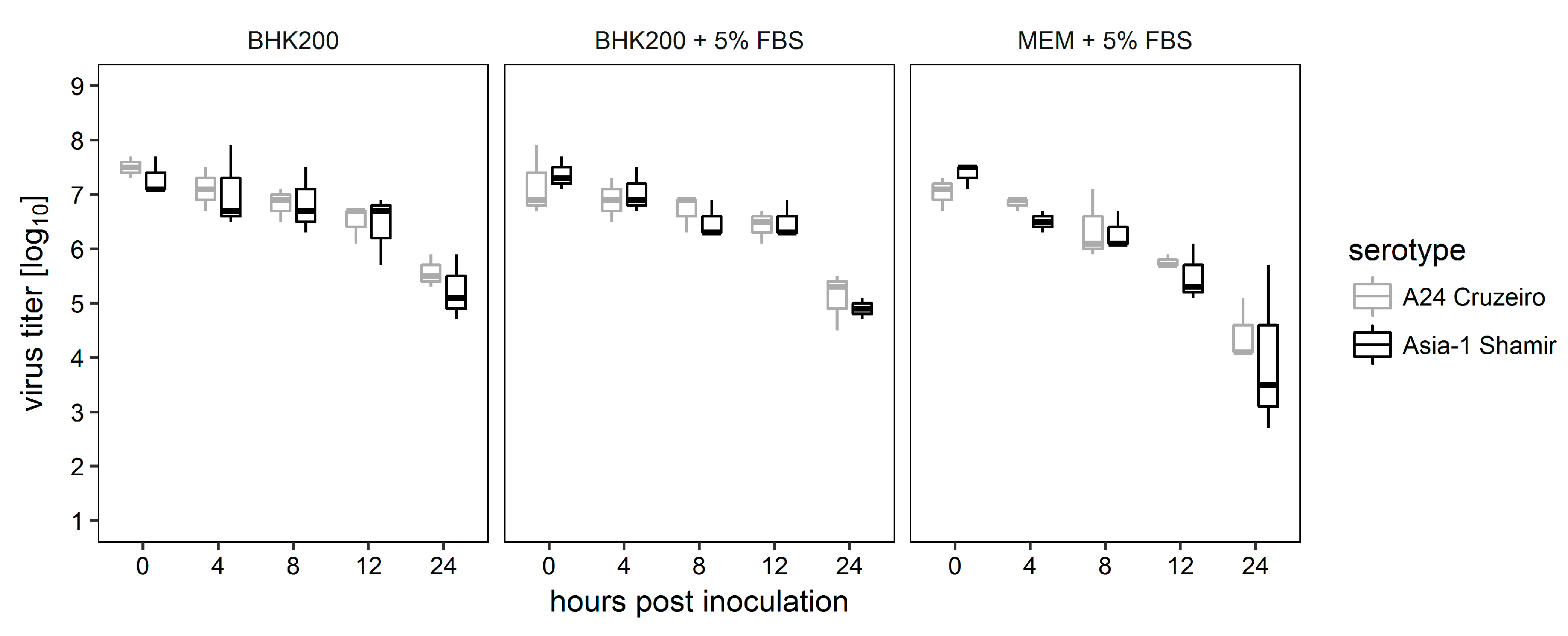
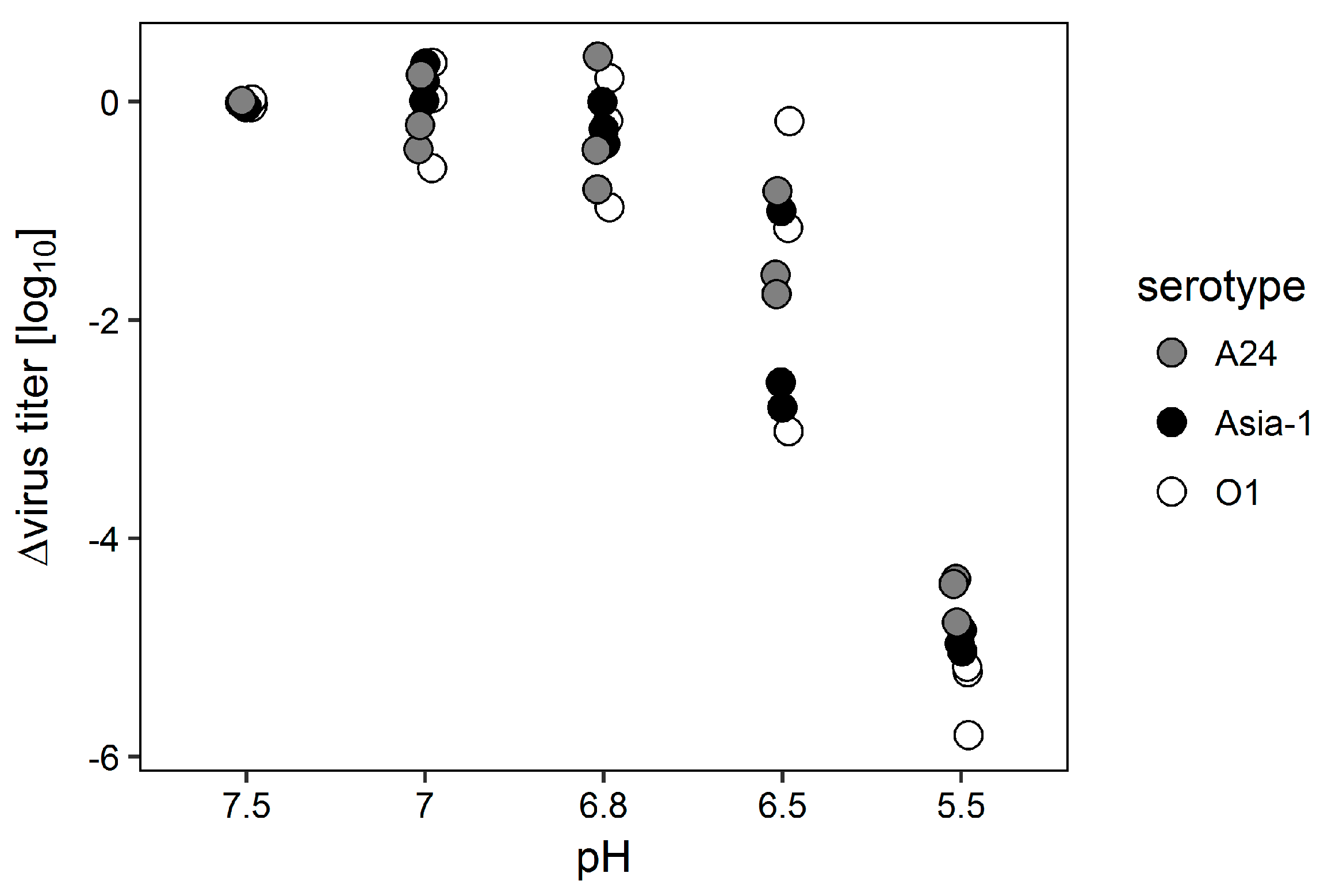
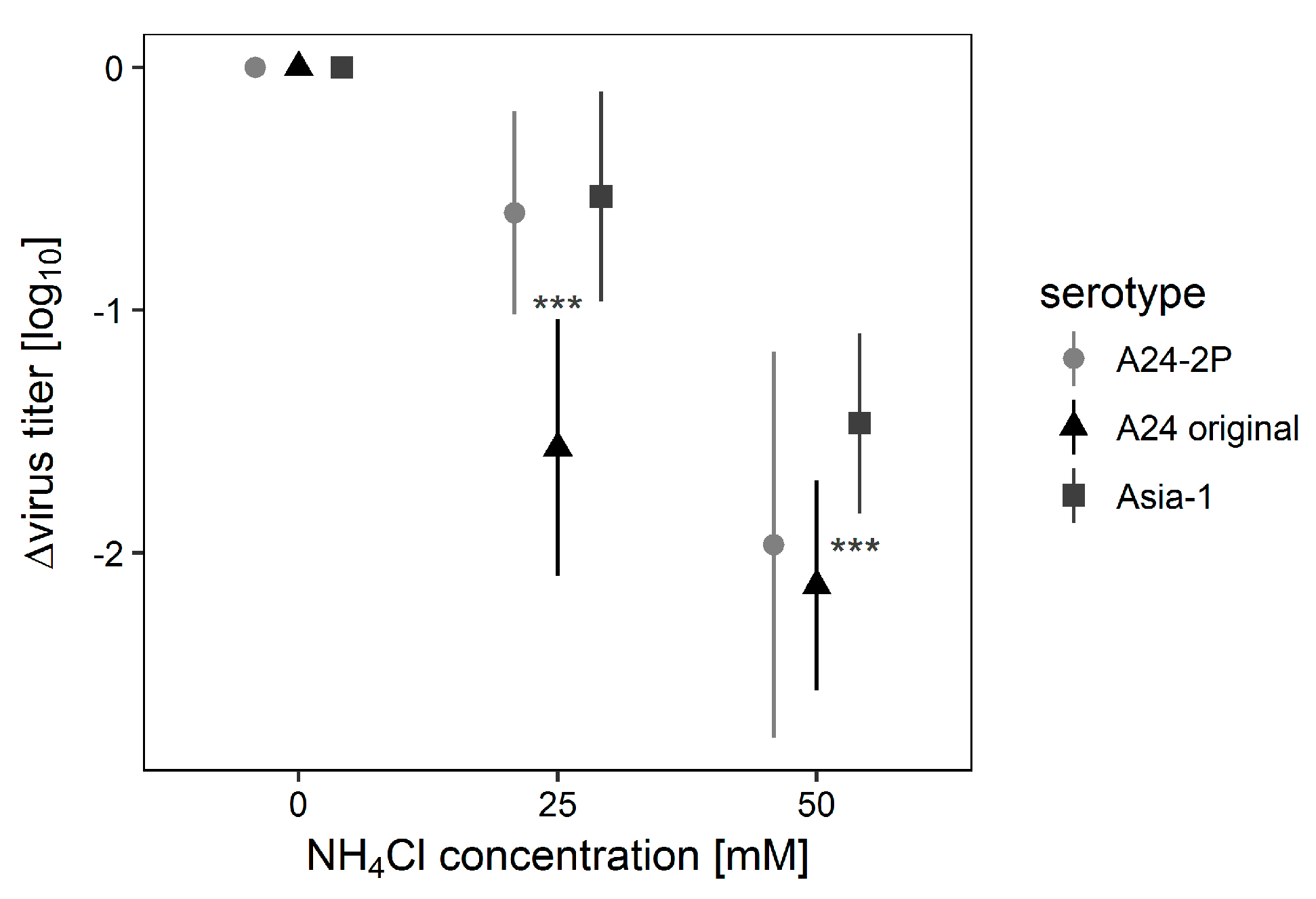


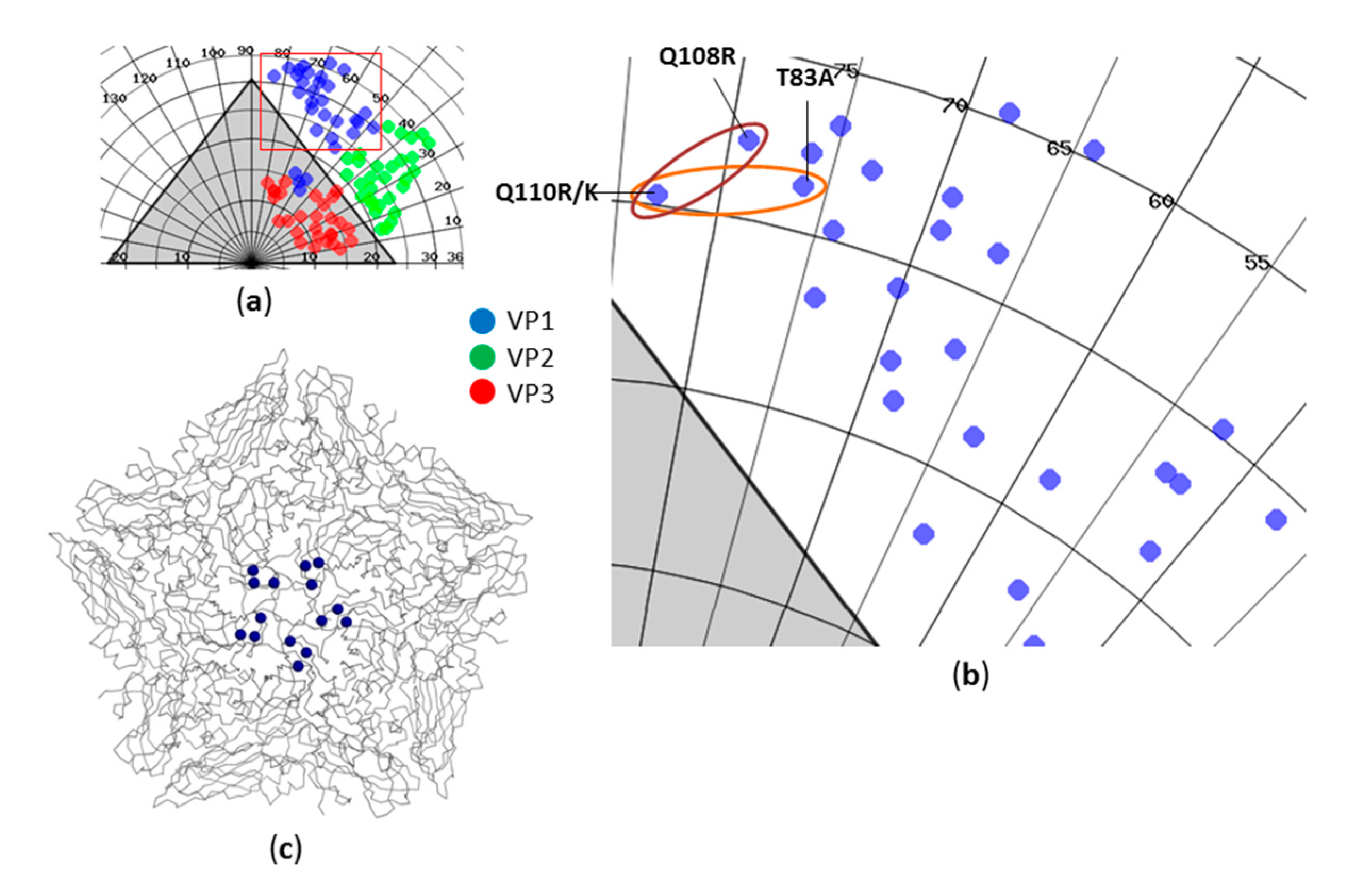
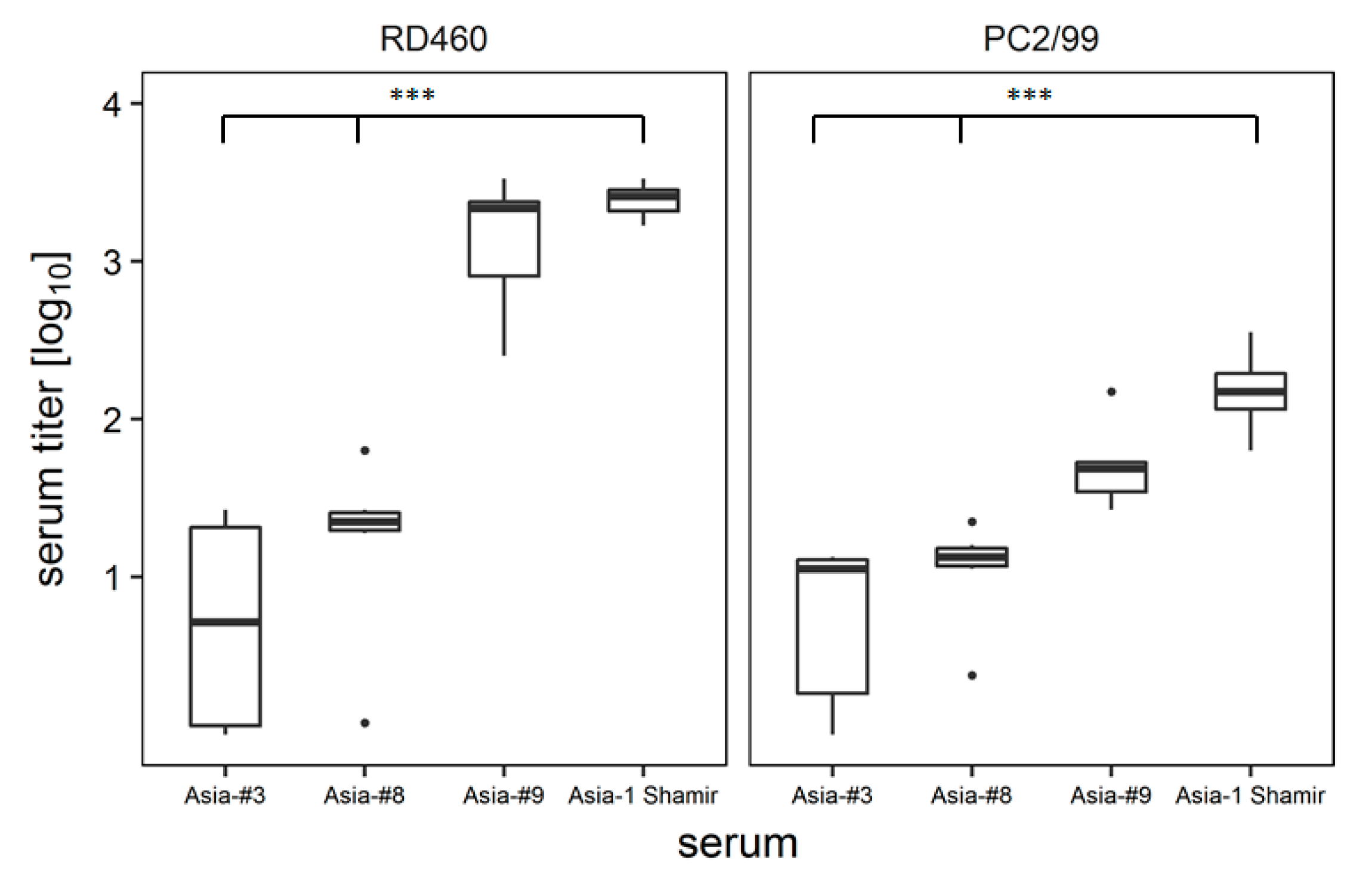
| Passage No. | #3 Virus from BHK21C13 in Cellvento™ BHK200 | NC | ||||
| Cell Viability 0 hpi | Cell Viability 20 hpi | Viral Titer 0 hpi * | Viral Titer 20 hpi * | Infection Volume | Cell Viability 20 hpi | |
| 1 | 98% | 63% | 4.9 | 5.9 | 5 mL | 99% |
| 2 | 99% | 73% | 5.5 | 5.7 | 5 mL | 98% |
| 3 | 99% | 79% | 5.7 | 5.9 | 5 mL | 96% |
| 4 | 99% | 60% | 5.3 | 6.1 | 5 mL | 99% |
| 5 | 99% | 13% | 5.5 | 5.9 | 5 mL | 98% |
| 6 | 97% | 6% | 5.5 | 6.1 | 4 mL | 97% |
| 7 | 97% | 16% | 4.9 | 6.1 | 3 mL | 99% |
| 8 | 98% | 5% | 5.3 | 5.9 | 1.5 mL | 97% |
| 9 | 98% | 8% | 4.3 | 6.1 | 0.5 mL | 96% |
| Passage No. | #8 Virus from BHK21-InVitrus Cells in Cellvento™ BHK200 | NC | ||||
| Cell Viability 0 hpi | Cell Viability 20 hpi | Viral Titer 0 hpi * | VIRAL titer 20 hpi * | Infection Volume | Cell Viability 20 hpi | |
| 1 | 98% | 60% | 4.7 | 5.7 | 5mL | 99% |
| 2 | 99% | 72% | 5.5 | 5.9 | 5mL | 98% |
| 3 | 99% | 86% | 5.9 | 6.1 | 5 mL | 96% |
| 4 | 99% | 53% | 5.5 | 5.9 | 5 mL | 99% |
| 5 | 99% | 16% | 5.1 | 6.3 | 5 mL | 98% |
| 6 | 97% | 10% | 5.5 | 5.9 | 4 mL | 97% |
| 7 | 97% | 12% | 5.1 | 6.3 | 3 mL | 99% |
| 8 | 98% | 6% | 5.3 | 5.9 | 1.5 mL | 97% |
| 9 | 98% | 9% | 4.1 | 6.5 | 0.5 mL | 96% |
| Passage No. | #9 Virus from Production BHK Cells in Cellvento™ BHK200 | NC | ||||
| Cell Viability 0 hpi | Cell Viability 20 hpi | Viral Titer 0 hpi * | Viral Titer 20 hpi * | Infection Volume | Cell Viability 20 hpi | |
| 1 | 98% | 61% | 5.9 | 6.3 | 5 mL | 99% |
| 2 | 99% | 8% | 5.5 | 5.9 | 5mL | 98% |
| 3 | 99% | 14% | 5.1 | 6.1 | 3 mL | 96% |
| 4 | 99% | 2% | 4.9 | 6.1 | 1.5 mL | 99% |
| 5 | 99% | 3% | 3.9 | 5.7 | 0.5 mL | 98% |
| Protein | Structure * | Virus Isolate | ||
|---|---|---|---|---|
| #3 Asia-1 | #8 Asia-1 | #9 Asia-1 | ||
| VP3 | beta-B ‘knob’ | - | - | E59K |
| VP1 | capsid surface | - | - | T83A |
| VP1 | capsid surface | Q108R | Q108R | - |
| VP1 | capsid surface | Q110R | Q110R | Q110K |
| VP1 | C-terminus | - | - | E202K |
| 2C | - | K285Q | K285Q | K285Q |
| Cell Line | Virus Isolate | |||
|---|---|---|---|---|
| Asia-1 Shamir | #3 Asia-1 | #8 Asia-1 | #9 Asia-1 | |
| CHO-K1 | negative | 3.7 ± 0.5 | 3.7 ± 0.6 | 4.2 ± 0.6 |
| CHO677 | negative | 2.4 ± 0.5 | 2.2 ± 0.2 | 3.8 ± 0.7 |
© 2017 by the authors. Licensee MDPI, Basel, Switzerland. This article is an open access article distributed under the terms and conditions of the Creative Commons Attribution (CC BY) license (http://creativecommons.org/licenses/by/4.0/).
Share and Cite
Dill, V.; Hoffmann, B.; Zimmer, A.; Beer, M.; Eschbaumer, M. Adaption of FMDV Asia-1 to Suspension Culture: Cell Resistance Is Overcome by Virus Capsid Alterations. Viruses 2017, 9, 231. https://doi.org/10.3390/v9080231
Dill V, Hoffmann B, Zimmer A, Beer M, Eschbaumer M. Adaption of FMDV Asia-1 to Suspension Culture: Cell Resistance Is Overcome by Virus Capsid Alterations. Viruses. 2017; 9(8):231. https://doi.org/10.3390/v9080231
Chicago/Turabian StyleDill, Veronika, Bernd Hoffmann, Aline Zimmer, Martin Beer, and Michael Eschbaumer. 2017. "Adaption of FMDV Asia-1 to Suspension Culture: Cell Resistance Is Overcome by Virus Capsid Alterations" Viruses 9, no. 8: 231. https://doi.org/10.3390/v9080231






